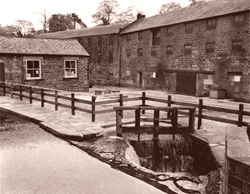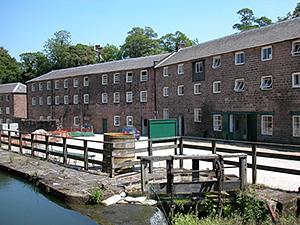
The developments in the British Midlands of the industrial revolution have coined the textiles industry possibly like no other.
It was is this area that we find the roots to the modern textile industry, including case studies that (nearly) could be dated from our modern times. And that in many more aspects than just one: the approach to innovation, the business models pursued, the ingenuity of factory patrons and how they rose rose from rags to riches; but also the social, labour, environmental and ethical issues we encounter in the present.
Not many of these historic sites still survive, and even fewer are well document. But there are exceptions that give us a fairly good idea how the mills were operated in the past, the profits they made, or what working in them meant for the workers.
One of the most notably exception is the area in and around the Peak District, and specifically the Derwent Valley (today a Unesco World Heritage Site) home to a total of 838 listed buildings, made up of a mixture of mills, workers’ housing, and structures associated with the mill communities.
From the remainders, archives and historical records the industrial revolution left behind in the area, we can gain many an insight that will trigger a simple ‘déjà-vu’ when taking note of news about textile factories from the Far East that with regularity hit our headlines.

Taking the example of the cotton mill, located in Derbyshire at Belper, Milford and Cromford, the latter now hosts the Derwent Valley visitor centre – What do we know from that time?
- Starting from 1772, the mills ran day and night with two 12 h shifts.
- The Cromford mill was originally started with 200 workers, more than the locality could provide, so the factory founder, Arkwright by name, built housing for them nearby, one of the first manufacturers to do so.
- Most of the employees were women and children, the youngest being only 7 years old. Later, the minimum age was raised to 10.
- The children were given 6 hours of education a week, so that they could do the record keeping that their illiterate parents could not.
- The children were an integral part of the workforce, and had dedicated jobs depending on age and size: collecting the fluff under the spinning machines is one example; cleaning out the bale ripper another.
- There are records of children caught in the spinning machinery, or in the bale ripper. With usually a gruesome and fatal result. To add insult to injury: the parents were usually made to pay for the cotton wasted by the child’s blood – cotton was widely considered the more expensive and valuable of the two ‘commodities’.
- For the children, as much as for the adults, working in the mills was considered a privilege,’easy’ and relatively well paid – the only alternative were the Peak District’s mines.
- In 1817, 650 and 300 children attended Sunday Schools in Belper and Milford respectively.
- The child labour issue was so prevalent that the British parliament passed three related laws consecutively (called Factory Acts): Regulation Act of 1819 (which set the minimum working age at 9 and maximum working hours at 12), the Regulation of Child Labor Law of 1833 (which established paid inspectors to enforce the laws) and the Ten Hours Bill of 1847 (which limited working hours to 10 for children and women).
- The mills run by the Strutt (Belper, Milford) family also suffered in the 19th century from a lack of modernisation; although they were at the forefront of fireproofing technology at the start of the 19th century, as the machines the mills used got bigger and more powerful, they persevered with child labour where adults would have been more adept at using the machinery. The company declined and in the second half of the 19th century some of its mills were leased or sold off to other companies
Further information:
- Wikipedia: Derwent Valley Mills.
- Derwent Valley World Heritage Site
- Child Labor during the British Industrial Revolution, article by Carolyn Tuttle, EH.Net Encyclopedia, edited by Robert Whaples. August 14, 2001.
- Samples of factory inspection reports, from the National Archives

